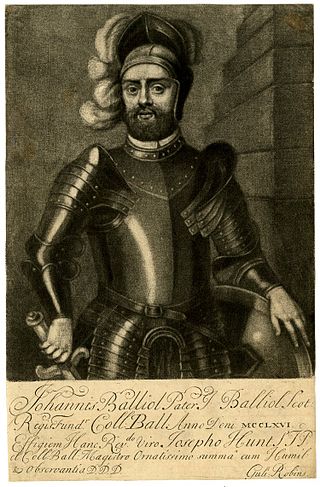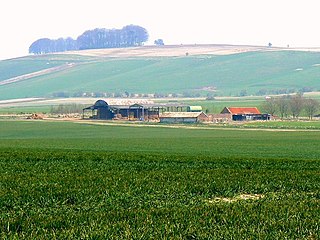
Magna Carta Libertatum, commonly called Magna Carta, is a royal charter of rights agreed to by King John of England at Runnymede, near Windsor, on 15 June 1215. First drafted by the Archbishop of Canterbury, Cardinal Stephen Langton, to make peace between the unpopular king and a group of rebel barons, it promised the protection of church rights, protection for the barons from illegal imprisonment, access to swift justice, and limitations on feudal payments to the Crown, to be implemented through a council of 25 barons. Neither side stood behind their commitments, and the charter was annulled by Pope Innocent III, leading to the First Barons' War.

Stephen Langton was an English Cardinal of the Roman Catholic Church and Archbishop of Canterbury between 1207 and his death in 1228. The dispute between King John of England and Pope Innocent III over his election was a major factor in the crisis which produced Magna Carta in 1215. Cardinal Langton is also credited with having divided the Bible into the standard modern arrangement of chapters used today.

Hubert de Burgh, Earl of Kent was an English nobleman who served as Chief Justiciar of England and Ireland during the reigns of King John and of his son and successor King Henry III and, as a consequence, was one of the most influential and powerful men in English politics in the thirteenth century.

Gilbert de Clare, 4th Earl of Hertford, 5th Earl of Gloucester, 1st Lord of Glamorgan, 7th Lord of Clare was the son of Richard de Clare, 3rd Earl of Hertford (c. 1153–1217), from whom he inherited the Clare estates. He also inherited from his mother, Amice Fitz William, the estates of Gloucester and the honour of St. Hilary, and from Rohese, an ancestor, the moiety of the Giffard estates. In June 1202, he was entrusted with the lands of Harfleur and Montrevillers.

Henry Stafford, 1st Earl of Wiltshire was an English peer.

John de Balliol was an English nobleman, belonging to the House of Balliol. Balliol College, in Oxford, is named after him.

Winterbourne Bassett is a small village and civil parish in Wiltshire, England, about 6 miles (10 km) southwest of Swindon and 7 miles (11 km) northwest of Marlborough.

William Marshal, 2nd Earl of Pembroke was a medieval English nobleman and was one of Magna Carta sureties. He fought during the First Barons' War and was present at the Battle of Lincoln (1217) alongside his father William Marshal, 1st Earl of Pembroke, who led the English troops in that battle. He commissioned the first biography of a medieval knight to be written, called L'Histoire de Guillaume le Mareschal, in honour of his father.

Henry Scrope, 3rd Baron Scrope of Masham KG, also known in older sources as Lord Scrope was a favourite of Henry V, who performed many diplomatic missions. He was beheaded for his involvement in the notional Southampton Plot to assassinate the king. Some historians believe that the charge was trumped-up to punish him for other acts of disloyalty, and that there may never have been such a plot.

Ranulf de Blondeville, 6th Earl of Chester and 1st Earl of Lincoln, known in some references as the 4th Earl of Chester, was one of the "old school" of Anglo-Norman barons whose loyalty to the Angevin dynasty was consistent but contingent on the receipt of lucrative favours. He has been described as "almost the last relic of the great feudal aristocracy of the Conquest".
Jocelin of Wells was a medieval Bishop of Bath. He was the brother of Hugh de Wells, who became Bishop of Lincoln. Jocelin became a canon of Wells Cathedral before 1200, and was elected bishop in 1206. During King John of England's dispute with Pope Innocent III, Jocelin at first remained with the king, but after the excommunication of John in late 1209, Jocelin went into exile. He returned to England in 1213, and was mentioned in Magna Carta in 1215.
William Malet, feudal baron of Curry Mallet in Somerset, was one of the guarantors of Magna Carta. In 1190, he accompanied King Richard the Lionheart on third crusade. While still on crusade in 1191, he took part in the Siege of Acre. Upon returning to England, he served as Sheriff of Somerset and Dorset in 1209. The precise nature of his relationship to an earlier William Malet is unknown.

Robert de Vere, hereditary Master Chamberlain of England, was the son of Aubrey de Vere, 1st Earl of Oxford, and Agnes of Essex. He succeeded his brother as the third Earl of Oxford, and was one of the twenty-five guarantors of Magna Carta.
Philip Basset was the Justiciar of England.

Mary Arundell, Countess of Arundel, was an English courtier. She was the only child of Sir John Arundell of Lanherne, Cornwall, by his second wife, Katherine Grenville. She was a gentlewoman at court in the reign of King Henry VIII, serving two of Henry VIII's Queens, and the King's daughter, Princess Mary. She was traditionally believed to have been "the erudite Mary Arundell", the supposed translator of verses now known to have been the work of her stepdaughter, Mary FitzAlan, later the first wife of Thomas Howard, 4th Duke of Norfolk.

John de Lacy, 2nd Earl of Lincoln was hereditary Constable of Chester, 7th Baron of Pontefract, 8th Baron of Halton and 8th Lord of Bowland.

William I de Cantilupe 1st feudal baron of Eaton (Bray) in Bedfordshire, England, was an Anglo-Norman royal administrator who served as steward of the household to King John and as Baron of the Exchequer.
Gilbert Basset was an English baronial leader during the reign of King Henry III.
Alan de Neville, sometimes known as Alan de Neville Junior, was an English landowner in Lincolnshire, England. He is often confused with another Alan de Neville who was active around the same time but who was a royal forester. It is possible that the landholder was the son of the forester, but this is not certain. The uncertainty continues as to his children, with some sources saying he had four sons while others say he had no children. It is known that Neville co-founded Tupholme Abbey in Lincolnshire.

Thomas Basset, called Thomas Basset of Headington or Thomas Basset of Colinton, was an Anglo-Norman lord and royal counsellor to King John of England.














